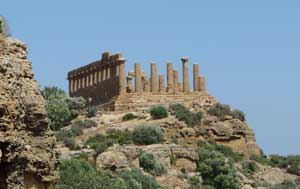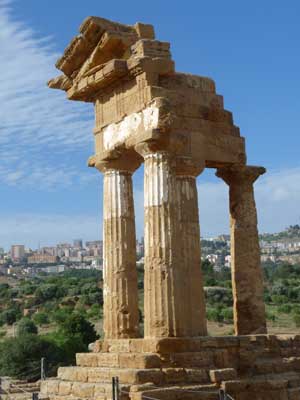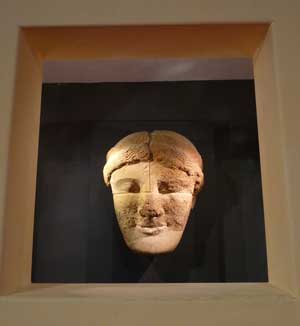Agrigento, Sicily’s most famous Greek site, is famous above all for its ‘Valley of the Temples’ (Valle dei Templi) and tourists in a hurry – such as those on organised cruise ship excursions – will visit only this spot. However, there is a great deal more to Agrigento, and you should really allow at least one whole day – or 24 hours – to visit the town. Serious history-lovers will find plenty to interest them for a longer stay. This page will provide suggestions for the best way to spend your first, or only day in Agrigento.
- Agrigento tourist information – a brief introduction with travel and accommodation advice
- Sicily destinations and practicalities: full menu (at foot of this page)
The most scenic way to arrive in Agrigento is from the south, from the sea. The view of the Greek temples and the hilltop city backdrop must be one of the most memorable panoramas in Europe. If you have a hotel or B&B booked in Agrigento, the best way to begin is to check in at your accommodation, pick up practical advice and the latest opening times from your receptionist, and buy some bus tickets if necessary. Then head, by bus, car or on foot to the Valley of the Temples.
Valley of the Temples
You will soon learn in Agrigento that names tend to revolve around tradition rather than accuracy. The Valley of the Temples is in fact a hill, a long ridge between the higher modern hilltop town of Agrigento and the distant sea. Between the town centre and the temples lies a real valley, a peaceful green vale where agriculture is interspersed with ruins and excavations. This is where a large part of the ancient city stood: one of the first surprising facts about Agrigento is that the ancient town was more extensive than the modern one. The Greek city was called Akragas and the later Roman town was named Agrigentum. The medieval name for the town was Girgenti, and this name was used until 1927, when ‘Agrigento’ was adopted as a PR move to honour the city’s past
It is possible to walk downhill to the archaeological zone from central Agrigento, but it is a lot quicker and more efficient to take the local buses (numbers 1, 2 or 3) which run frequently (less often on Sundays), with a stop outside the railway station. Buy single or day tickets in advance from a newsagent, bar or tabacchi, and ask the driver to let you off for the Valle dei Templi.
The archaeological area of the Valley of the Temples spreads out both sides of the main road. Buses stop on the road directly between the entrances, by a very useful cafe-bar where you can buy refreshments, rolls and light meals. The ticket office, at the time of writing, lies on the eastern side of the road, at the entrance to the most dramatic part of the site. Like all State archaeological sites and museums in Italy, there is free entrance for EU citizens under 18 and reduced prices for some other visitors (take your passport as proof of your age).
There are two car parks for the temple site, one to the east by the Temple of Juno and one by the western half of the site – follow signs from the main road. There is a charge for parking. A useful Google map showing the temples, car parks and facilities can be found on the official Parco Valle dei Templi website.
The eastern temples

The eastern half of the Valley of the Temples contains the most complete and impressive temple ruins. The temples at Agrigento have traditional names, based on the interpretations of historians over the last couple of centures: these are nearly all likely to be inaccurate, though, so the modern custom is to refer to them by letter.
The closest temple to the road is Temple A, also called the Temple of Herakles. This is the most ancient of the remaining temples at Agrigento, dating to the sixth century BC, not long after the city was founded. From the temple there are views over the countryside to various other dotted ruins, including the so-called Tomba di Theron, a tower structure thought for years to have been the grave of a famous ruler of Greek Akragas, but now identified as a Roman funerary monument.
The next temple along the ridge is the most complete, with its monumental structure largely intact due to its early conversion into a Christian church. This is the Temple of Concord, or Temple F, one of the best-preserved temples of the ancient world. Occasionally, for special events, you may be able to enter the structure, although this is rare. The Agrigento temples are in the Doric style; an unusual feature is that they had stairways giving access to the roof; the site of these steps is visible in the Temple of Concord.
The bare rocks of the Temple ridge served as part of Akragas’s city defences, and they were built up with blocks of stone where necessary, joining onto the city wall. Much later, this site continued to be a sacred complex, with the pagan gods giving way to Christianity. Around the church of the Temple of Concord were more religious developments, including graveyards. The dead were interred in caves and in niches cut into the rock, which are still visible underfoot and in the vertical rock faces.
At the far end of the hill is Temple D, generally called the Temple of Hera or Juno. There are some standing columns, the remains of a huge stone sacrificial altar alongside, and steps where the masonry still shows traces of the fires of 406 BC, when Akragas was conquered and sacked by the Carthaginians.
The western half

On the western side of the road is the remains of one of the biggest temples of antiquity, the Temple of Olympian Zeus, otherwise known as Temple B, though there can be no doubt about the identification of this one. The gigantic ruins cover a huge area, and unfortunately it is almost impossible to build up an image of this temple from the scattered, massive heaps of stone which we can see today. The ambitious building project was probably never completed, is likely to have been damaged by the Carthaginian invaders, and as recently as the eighteenth century, much of the temple’s stonework was carted off to the sea to build the docks at Porto Empedocle. There have been various speculative reconstructions of the temple’s design; a model of the most convincing recreation can be seen in the archaeological museum nearby.
The most striking thing about the Temple of Zeus would have been its vast scale – it was over 110 metres long- and the second most striking the giant statues, called telamons, incorporated into the edifice, probably placed on an upper level and supporting part of the structure’s weight. A copy of one of these statues, which were made from several blocks of stone, lies on the ground alongside the ruins. A telamon is reconstructed in its original upright position inside the archaeological museum.
The other ruins in this western part of the site are extensive, but less dramatic to the untrained eye. Low excavated walls and paving mark the locations of various religious buildings and shrines. This appears to have been a sacred zone from the earliest days of the settlement of Akragas, dedicated to earth deities such as Demeter and Kore (Persephone). A temple-corner here, known as the Temple of the Dioscuri, was actually re-erected, perhaps inaccurately, in the nineteenth century. On the upright columns you can still see the white stucco which was used to decorate the Agrigento temples – although they are now a harmonious sand colour, the natural shade of the local limestone, in antiquity they would have been very different; with brightly-coloured painted friezes and white stucco facing.
Beyond the ruins is a pretty green gorge, once a water reservoir and fish-pond for Akragas, said to have constructed by Carthaginian prisoners of war. Nowadays the heritage organisation FAI has turned the valley into charming citrus gardens, the Giardino della Kolymbetra, displaying traditional types of citrus trees, plants and irrigation methods. It’s a refreshing and pleasant diversion from the dusty temple landscape above, but if you are following a strict one-day itinerary, you may not have time. There’s a small additional charge for visiting the gardens, though UK National Trust members have free admission (take your membership card). The garden is entered from within the archaeological zone.
Timing and practicalities
To explore both halves of the Valle dei Templi site, with breaks for refreshments, reading background information, dodging tour parties, or visiting the gardens, you should allow at least three hours and try to avoid setting a deadline. A guidebook or historical map with some explanations of the site will be a very helpful accessory. As well as the roadside cafe, there is also a cafe-bookshop in the eastern half of the site, with pleasant outdoor tables and public toilets. Take a bottle of water and sun protection in the summer. Distributed around the site there are drinking-water fountains – however, when I visited they bore warning signs asserting that the water was not drinkable. Personally I was sceptical, but can bear no responsibility for anyone putting it to the test.
Archaeological Museum

While it is true that many tourists are content to see the temples and move on, I’d strongly recommend a visit to the archaeological museum, which contains some impressive exhibits and helps to put the Agrigento temples into context. If you’re in a hurry, just stroll around and look at the highlights. Check the latest opening times when you plan your one-day itinerary; at the time of writing the museum is closed on Sunday, Monday and public holiday afternoons. It is located on the main road between the temple site and the town; the buses from central Agrigento stop close by; ask the driver for the stop.
The museum covers the history of Agrigento from the earliest human settlement. One of the highlights is a Greek vase showing Perseus lounging, while admiring the captive Andromeda; another is a Greek marble statue of a warrior. There is a touching Roman sarcophagus portraying the death of a young boy amid his grieving family. Downstairs are various exhibits relating to the Temple of Zeus, including a model of how the temple may have looked; a useful way to make sense of today’s ruins. Some of the more decorative stonework from the temples, including lion’s-head water-spouts, is held in the museum, so paying a visit here is a useful addition to your time at the temple site.
More of Agrigento
Seeing the Valley of the Temples and the museum may take the whole of your day in Agrigento. But if you have time and energy, try embarking on a brief exploration of the ‘modern’ town. Far from being recent, the town centre is a medieval network of steep alleys and stairways – picturesque and historic, though quite strenuous to explore at speed. At the top lies the Duomo and a short distance downhill is one of the most significant sights of Agrigento, the church of Santa Maria dei Greci. This is a charming church, but its really impressive feature is what lies underneath. The church, as was often the case, was built over an earlier religious site: in this case, a Greek temple. You can see the steps and foundations of the temple below the church, by descending some steps just outside the church. Glass panels in the church floor allow you to see more of the temple below, and also stone-carved seats where – according to the ghoulish attendant – in Christian times dead monks would be placed until mummified. This submerged temple, possibly dedicated to Athena, is like a jigsaw piece; a useful reminder that much of ancient Akragas lies beneath later buildings and is, for now, lost to history. There would have been other temples and public buildings around the summit of the hill now crowned by Agrigento’s imposing Duomo: the Greek town’s acropolis would have been spread over the hilltop.
If you have managed to squeeze the temples, the museum and the town into one day, you have done very well. This itinerary covers the most important sights of Agrigento and provides a good picture of the scale and nature of the ancient city of Akragas. Nevertheless, I found that this whistle-stop tour wasn’t enough, and I wished for longer to explore the town and its other archaeological sights with more leisure and more opportunity for learning and observing history.
> Agrigento tourist information – a brief introduction with travel and accommodation advice
If you like Agrigento, you may like
Paestum, Campania
Segesta, Sicily
Useful external links
Parco Valle dei Templi – official website
Valley of the Temples – tour guides & information